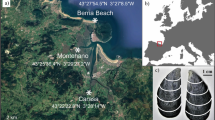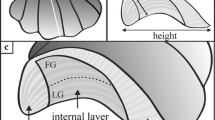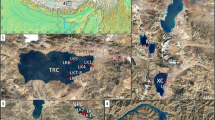Abstract
The aragonitic shell of the photosymbiont-bearing bivalve Tridacna maxima contains a record of the physiological and environmental changes the organism has experienced during its lifetime. This record is preserved as chemical and microstructural variations throughout the shell. Stable isotopic analyses of oxygen (18O/16O) and carbon (13C/12C) in shell carbonate were combined with growth increment studies to interpret the shell record of specimens collected from the Rose Atoll (Lat. 14°31′S; Long. 168°10′W) in April 1982. The seasonal water temperature cycle is recorded in the oxygen isotopic signature of the clams, permitting the recognition of annual cycles in the δ18O profile. The total number of these cycles corresponds to the age of a specimen, while the cycle length is a measure of the yearly growth rate. Large-amplitude cycles, reflecting year-round calcification, characterize the early portion of the growth record. With the onset of sexual maturity and slower growth at an age of approximately ten years, the cycles decrease in amplitude and become more erratic. During this later growth phase calcification is limited to the cooler months of the year, perhaps in response to a re-ordering of energy priorities between growth and gametogenesis. A growth curve developed from the δ18O profile indicates rapid juvenile shell growth followed by slower growth thereafter producing a lifespan of several decades. Carbon isotopic analyses of T. maxima were compared to analyses of the symbiont-barren gastropod Terebra areolata collected from the same locality in April 1984. A 2‰ depletion in the δ13C composition of T. maxima shell carbonate is attributed to a symbiontenhanced metabolic rate and an increased flow of isotopically light, respired CO2 into the carbon pool used in calcification. Such a depletion may prove useful in identifying the presence of photosymbionts in extinct species of fossil mollusks.
Similar content being viewed by others
Literature cited
Abbott, T. R. and P. S. Dance: compendium of seashells, 411 pp. New York: E. P. Dutton Inc. 1982
Aharon, P.: Stable isotope geochemistry of a Late Quaternary reef environment, New Guinea: application of high resolution data to palaeoclimatology, 259 pp. Ph. D. dissertation. Australian National University 1980
Aharon, P. and J. Chappell: Carbon and oxygen isotope probes of reef environment histories. In: Perspectives on coral reefs, pp 1–15. Ed by D. J. Barnes. Canberra: Brain Cloustin Publishers 1983
Bonham, K.: Growth rate of giant clam Tridacna gigas at Bikini Atoll as revealed by radioautography. Science, Wash., D.C. 149, 300–302 (1965)
Chivas, A. R., P. Aharon, J. Chappell, C. Vlastuin and E. Kiss: Trace elements and stable-isotope ratios of annual growth bands as environmental indicators. In: Inaugural Proceedings of the Great Barrier Reef Conference, pp 77–82. Ed. by J. T. Baker, R. M. Carter, P. W. Sammaro and K. P. Stark. Townville: JCU Press 1983
Craig, H. and L. I. Gordon: Deuterium and oxygen-18 variations in the ocean and marine atmosphere. In: Stable isotopes in oceanographic studies and palaeotemperatures, pp 1–122. Ed. by E. Tongiori. Rome: Consiglio Nazionale delle Ricerche 1965
DeNiro, M. J. and S. Epstein: You are what you eat (plus a few ‰): the carbon isotope cycle in food chains. Geol. Soc. Am. Abstr. Progr. 8, 834–835 (1976)
Emrich, K., D. H. Enhalt and J. C. Vogel: Carbon isotope fractionation during the precipitation of calcium carbonate. Earth planet. Sci. Lett. 8, 363–371 (1970)
Epstein, S., R. Buchsbaum, H. A. Lowenstam and H. C. Urey: Revised carbonate-water isotopic temperature scale. Bull. geol. Soc. Am. 64, 1315–1325 (1953)
Erez, J.: Vital effect on stable isotope composition in foraminifera and coral skeletons. Nature, Lond. 273, 199–202 (1978)
Goreau, T. F., N. I. Goreau and C. M. Yonge: On the utilization of photosynthetic products from zooxanthellae and of a dissolved amino acid in Tridacna maxima f. elongata. J. Zool. Lond. 169, 417–454 (1973)
Grossman, E. L.: Stable isotopes in live benthic foraminifera from the Southern California borderland, 164 pp. Ph.D. dissertation: University of Southern California 1982
Jameson, S. C.: Early life history of the giant clams Tridacna crocea Lamark, Tridacna maxima (Röding), and Hippopus hippopus Linnaeus. Pac. Sci. 30, 219–233 (1976)
Jaubert, J.: Light, metabolism, and the distribution of Tridacna maxima in a south Pacific atoll: Takapoto (French Polynesia), pp 489–494. Proc. Third Int. Coral Reef Symp. 1977
Jones, D. S., D. F. Williams and M. A. Arthur: Growth history and ecology of the Atlantic surf clam Spisula solidissima (Dillwyn) as revealed by stable isotopes and annual shell increments. J. exp. mar. Biol. Ecol. 73, 225–242 (1983)
Keith, M. L., G. M. Anderson and R. Eichler: Carbon and oxygen isotopic composition of mollusk shells from marine and fresh water environments. Geochim. cosmochim. Acta 28, 1757–1786 (1964)
Keith, M. L. and J. N. Weber: Systematic relationships between carbon and oxygen isotopes in carbonates deposited by modern corals and algae. Science, Wash. D.C. 150, 498–501 (1965)
Krantz, D. E., D. S. Jones and D. F. Williams: Growth rates of the sea scallop, Placopecten magellanicus, determined from the 18O/16O record in shell calcite. Biol. Bull mar. biol. Lab., Woods Hole 167, 186–199 (1984)
Kroopnick, P.: Correlations between δ13C and Σ CO2 in surface waters and atmospheric CO2. Earth planet. Sci. Lett. 22, 397–403 (1974)
Lutz, R. A. and D. C. Rhoads: Growth patterns within the molluscan shell: an overview. In: Skeletal growth of aquatic organism, pp 203–254. Ed. by D. C. Rhoads and R. A. Lutz. New York, Plenum Press 1980
Majewske, O. P.: Recognition of invertebrate fossil fragments in rocks and thin sections, 101 pp. Leiden: E. J. Brill 1969
Mansour, K.: Source and fate of the zooxanthellae of the visceral mass of Tridacna elongata. Nature, Lond. 158, 130 (1946a)
Mansour, K.: The zooxanthellae, morphological peculiarities and food and feeding habits of the Tridacnidae with reference to the other lamellibranchs. Proc. Egypt. Acad. Sci. 1, 1–11 (1946b)
McCrea, J. M.: On the isotopic chemistry of carbonates and a paleotemperature scale. J. Chem. Phys. 18, 847–849 (1950)
McMichael, D. F.: Growth rate, population, size and mantle coloration in the small giant clam Tridacna maxima (Röding), at One Tree Island, Capricorn Group, Queensland, pp 241–254, Proc. Second Int. Coral Reef Symp. 1974
Miller, B. A.: The biology of Terebra gouldi Deshayes 1859, and a discussion of life similarities among other Terebrids of similar proboscis type. Pac. Sci. 29, 227–241 (1975)
Muscatine, L.: Glycerol excretion by symbiotic algae from corals and Tridacna and its control by the host. Science, Wash. D.C. 156, 516–519 (1967)
Ricard, M. and B. Salvat: Faeces of Tridacna maxima (Mollusca-Bivalvia), composition and coral reef importance, pp 495–501. Proc. Third Int. Coral Reef Symp. 1977
Rosewater, J.: The family Tridacnidae in the Indo-Pacific. Indo-Pac. Mollusca 1, 347–396 (1965)
Simkiss, K.: Phosphates as crystal poisons of calcification. Biol. Rev. 39, 487–505 (1964)
Smith, B. N.: Natural abundances of the stable isotopes of carbon in biological systems. Bioscience 22, 226–231 (1972)
Taylor, J. D., W. J. Kennedy and A. Hall: The shell structure and mineralogy of the bivalvia. II. Lucinacea-Clavagellacea: conclusions. Bull. Br. Mus. nat. Hist. 22, 255–294 (1973)
Weber, J. N. and M. J. Woodhead: Carbon and oxygen isotope fractionation in the skeletal carbonate of reef-building corals. Chem. Geol. 6, 93–117 (1970)
Wilbur, K. M.: Shell structure and mineralization in mollusks. In: Calcification in biological systems, pp 15–40. Ed. by R. F. Sogonnaes. Washington D.C.: American Association For The Advancement Of Science 1960
Wilbur, K. M.: Shell formation and regeneration. In: Physiology of mollusca, pp 243–282. Ed. by K. M. Wilbur and C. M. Yonge. New York: Academic Press 1964
Wilbur, K. M.: Shell formation in mollusks. In: Chemical zoology, pp 103–145. Ed. by M. Florkin and B. T. Scheer. New York: Academic Press 1972
Wilbur, K. M. and A. S. M. Saleuddin: Shell formation. In: The mollusca, Vol. 4. Physiology Part I, pp 235–287. Ed. by A. S. M. Saleuddin and K. M. Wilbur. New York: Academic Press 1983
Williams, D. F., M. A. Sommer II and M. L. Bender: Carbon isotopic compositions of Recent planktonic foraminifera of the Indian Ocean. Earth planet. Sci. Lett. 36, 391–403 (1977)
Zahl, P. A. and J. J. A. McLaughlin: On the role of algal cells in the tissues of marine invertebrates. J. Protozool. 6, 344–352 (1959)
Author information
Authors and Affiliations
Additional information
Communicated by J. M. Lawrence, Tampa
Rights and permissions
About this article
Cite this article
Romanek, C.S., Jones, D.S., Williams, D.F. et al. Stable isotopic investigation of physiological and environmental changes recorded in shell carbonate from the giant clam Tridacna maxima . Mar. Biol. 94, 385–393 (1987). https://doi.org/10.1007/BF00428244
Accepted:
Published:
Issue Date:
DOI: https://doi.org/10.1007/BF00428244




